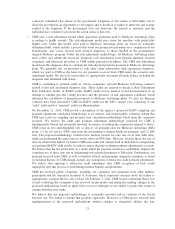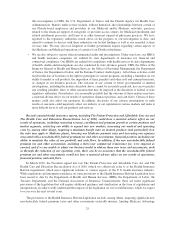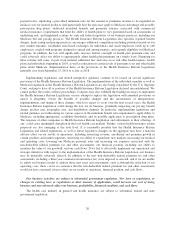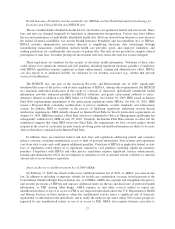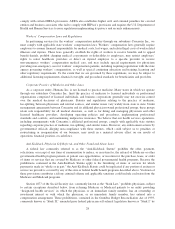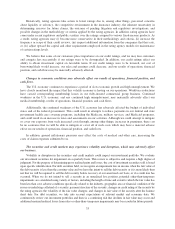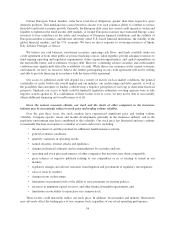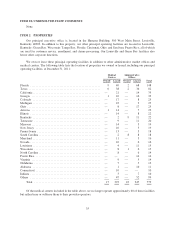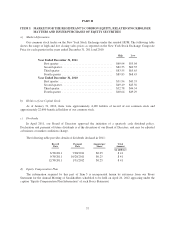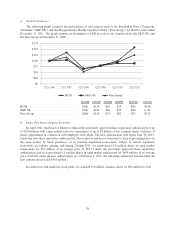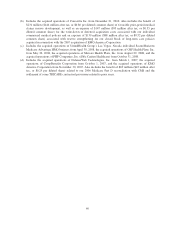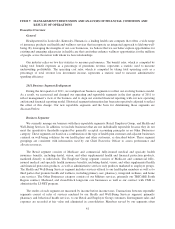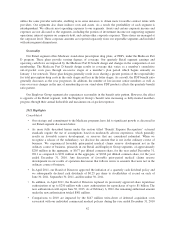Humana 2011 Annual Report Download - page 42
Download and view the complete annual report
Please find page 42 of the 2011 Humana annual report below. You can navigate through the pages in the report by either clicking on the pages listed below, or by using the keyword search tool below to find specific information within the annual report.uncertainties as to whether payors, pharmacy providers, pharmacy benefit managers, or PBMs, and others in the
prescription drug industry will continue to utilize AWP as it has previously been calculated, or whether other
pricing benchmarks will be adopted for establishing prices within the industry. Legislation may lead to changes
in the pricing for Medicare and Medicaid programs. Regulators have conducted investigations into the use of
AWP for federal program payment, and whether the use of AWP has inflated drug expenditures by the Medicare
and Medicaid programs. Federal and state proposals have sought to change the basis for calculating payment of
certain drugs by the Medicare and Medicaid programs. Adoption of ASP in lieu of AWP as the measure for
determining payment by Medicare or Medicaid programs for the drugs sold in our mail-order pharmacy business
may reduce the revenues and gross margins of this business which may result in a material adverse effect on our
results of operations, financial position, and cash flows.
If we do not continue to earn and retain purchase discounts and volume rebates from pharmaceutical
manufacturers at current levels, our gross margins may decline.
We have contractual relationships with pharmaceutical manufacturers or wholesalers that provide us with
purchase discounts and volume rebates on certain prescription drugs dispensed through our mail-order and
specialty pharmacies. These discounts and volume rebates are generally passed on to clients in the form of
steeper price discounts. Changes in existing federal or state laws or regulations or in their interpretation by courts
and agencies or the adoption of new laws or regulations relating to patent term extensions, and purchase discount
and volume rebate arrangements with pharmaceutical manufacturers, may reduce the discounts or volume rebates
we receive and materially adversely impact our results of operations, financial position, and cash flows.
Our ability to obtain funds from our subsidiaries is restricted.
Because we operate as a holding company, we are dependent upon dividends and administrative expense
reimbursements from our subsidiaries to fund the obligations of Humana Inc., our parent company. These
subsidiaries generally are regulated by states’ Departments of Insurance. We are also required by law to maintain
specific prescribed minimum amounts of capital in these subsidiaries. The levels of capitalization required
depend primarily upon the volume of premium generated. A significant increase in premium volume will require
additional capitalization from our parent company. In most states, we are required to seek prior approval by these
state regulatory authorities before we transfer money or pay dividends from these subsidiaries that exceed
specified amounts, or, in some states, any amount. In addition, we normally notify the state Departments of
Insurance prior to making payments that do not require approval. In the event that we are unable to provide
sufficient capital to fund the obligations of Humana Inc., our results of operations, financial position, and cash
flows may be materially adversely affected.
Downgrades in our debt ratings, should they occur, may adversely affect our business, results of
operations, and financial condition.
Claims paying ability, financial strength, and debt ratings by recognized rating organizations are an
increasingly important factor in establishing the competitive position of insurance companies. Ratings
information is broadly disseminated and generally used throughout the industry. We believe our claims paying
ability and financial strength ratings are an important factor in marketing our products to certain of our
customers. Our 7.20% and 8.15% senior notes are subject to an interest rate adjustment if the debt ratings
assigned to the notes are downgraded (or subsequently upgraded) and contain a change of control provision that
may require us to purchase the notes under certain circumstances. In addition, our debt ratings impact both the
cost and availability of future borrowings. Each of the rating agencies reviews its ratings periodically and there
can be no assurance that current ratings will be maintained in the future. Our ratings reflect each rating agency’s
opinion of our financial strength, operating performance, and ability to meet our debt obligations or obligations
to policyholders, but are not evaluations directed toward the protection of investors in our common stock and
should not be relied upon as such.
32



